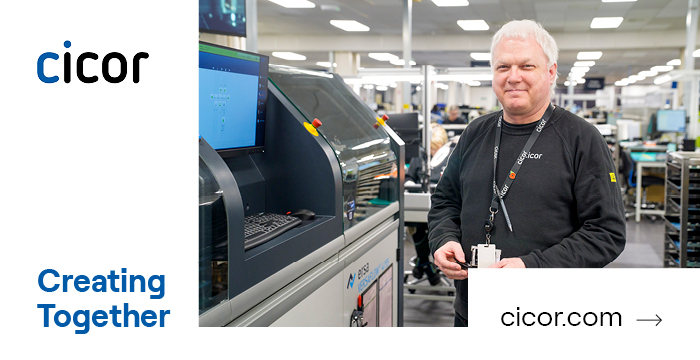
SMT & Inspection |
Fast, gentle and process-secure drying of MSDs
It is well-known that SMD components like QFPs and BGAs are moisture sensitive devices but LEDs and even ceramic capacitors are similarly at risk. Indeed, even printed circuit boards increasingly must be handled as MSDs, especially Multilayer- and Flex- printed boards.
These components absorb vapor throughout the surface which enters the basic material by diffusion. The issue is further intensified by ongoing miniaturization and the increasing application of extremely hygroscopic flame retardants in PCB manufacturing.
When the absorption of moisture exceeds a critical limit, there will be the typical technical failures associated with the release of the absorbed vapor during the soldering process. These include internal delamination of the semiconductor packaging material, bond damage, die lifting or even popcorning. Moisture control is an important task for the entire logistics chain, but historically the problem has only been addressed at final assembly, and often only after failures have already occurred. Over time, baking ovens have become a fixed part of many production lines. But more and more producers in the automotive, avionics, medical and telecoms engineering sectors are no longer satisfied with this approach. They are demanding an integrated Moisture Sensitive Management System which also includes the manufacturers of devices and the distributors, similar to that employed for ESD-protection.
The drying process
All of the components of the MSL classes 2a to 5a can be safely stored for an unlimited time according to the IPC/JEDEC-J-STD-033B.1 in an atmosphere with vapor content of less than 1,9g/m3. If the dehumidification of the ambient air is increased, the difference of the vapor pressure will be so high that the water molecules in the devices will overcome their adhesion forces, release, and the devices will dry. High efficiency Storage systems that create an atmosphere of 1-2% RH at room temperature and vapor content of less than 0.6g/m3 are essentially a “moisture vacuum,” forcing the release of the previously absorbed humidity. This revertive drying process is extremely gentle as the components are not exposed to any thermal stress and therefore the risks of oxidation and intermetallic growth are avoided.
To shorten the dying time, this process may be thermally enhanced, but to avoid problems of oxidation, it is essential that this process occurs in a “moisture vacuum” as well. New technology offered by Totech offers a solution to the demands for a reliable and effective drying system which can furthermore be easily integrated in the production process and make redundant the traditional tempering/after-baking at very high temperatures.

 The 60°C Adsorption Drying Cabinet
Adsorption is a process by which a thin layer of molecules adheres to the surface of another substance. The structure of the Zeolite desiccant used in these cabinets acts as a molecular sieve in removing water molecules from the air. The XSD Series Adsorption Drying Cabinets extend the energy-efficient drying process of all sensitive components with a balanced heat profile and robust insulation. Thus, it can be utilized for both the IPC-conforming tempering at 40°C and for the drying of reels or tubes at 50°C or of printed boards at 60°C.
These newly-developed high-performance drying cabinets achieve moisture parameters below 0.5% RH. Even opening the door causes humidity increases of barely 5% and recovery occurs within 300 seconds back below 1% RH. All settings are input via user-friendly Touch-screen interface. An integrated data-logger enables continuous recording of all relevant performance data such as moisture, temperature and door opening cycles. Measured data is provided by an extremely high speed response precision sensor which gives the basis for a reliable documentation in the context of Moisture-Sensitive-Management. Data is recorded on a SD-card for convenient external readout.
Is nitrogen storage still reasonable?
Still in use are nitrogen storage systems, with the nitrogen used to displace moist air present inside the cabinet. For this purpose however vast quantities of nitrogen are required. This is energy-consuming and produces high operating costs. To reach a humidity level of 5% RH, nitrogen cabinets must be flooded with a high volume flow rate lasting several minutes- replacing the cabinet volume several times. Moisture parameters of 1 or 2% RH are factually not achievable and for this reason there is no redrying that takes place. In high access rate situations, the cabinet is almost permanently flooded with nitrogen which leads to immense operating costs and enriches the ambient air with nitrogen. The benefits of this system arguably lie only with the nitrogen supplier.
The 60°C Adsorption Drying Cabinet
Adsorption is a process by which a thin layer of molecules adheres to the surface of another substance. The structure of the Zeolite desiccant used in these cabinets acts as a molecular sieve in removing water molecules from the air. The XSD Series Adsorption Drying Cabinets extend the energy-efficient drying process of all sensitive components with a balanced heat profile and robust insulation. Thus, it can be utilized for both the IPC-conforming tempering at 40°C and for the drying of reels or tubes at 50°C or of printed boards at 60°C.
These newly-developed high-performance drying cabinets achieve moisture parameters below 0.5% RH. Even opening the door causes humidity increases of barely 5% and recovery occurs within 300 seconds back below 1% RH. All settings are input via user-friendly Touch-screen interface. An integrated data-logger enables continuous recording of all relevant performance data such as moisture, temperature and door opening cycles. Measured data is provided by an extremely high speed response precision sensor which gives the basis for a reliable documentation in the context of Moisture-Sensitive-Management. Data is recorded on a SD-card for convenient external readout.
Is nitrogen storage still reasonable?
Still in use are nitrogen storage systems, with the nitrogen used to displace moist air present inside the cabinet. For this purpose however vast quantities of nitrogen are required. This is energy-consuming and produces high operating costs. To reach a humidity level of 5% RH, nitrogen cabinets must be flooded with a high volume flow rate lasting several minutes- replacing the cabinet volume several times. Moisture parameters of 1 or 2% RH are factually not achievable and for this reason there is no redrying that takes place. In high access rate situations, the cabinet is almost permanently flooded with nitrogen which leads to immense operating costs and enriches the ambient air with nitrogen. The benefits of this system arguably lie only with the nitrogen supplier.
 Oxidation protection by dry storage
In an extremely dry atmosphere there is no corrosion. There are two prerequisites for the occurrence of corrosion: there must be an oxidizing agent and an aqueous solution which operates as electrolyte. The oxygen in the air makes the oxidizing agent, the vapor the electrolyte. The critical limit at which an oxidation process with atmospheric oxygen takes place, lies, depending on the metal or alloy/composition, at 40 to 70% RH. This means that there are more than 8 grams of vapor per m3 present. The absolute humidity in the adsorptive dry cabinets is lower than 1.4g/m3 at a temperature of 60°C and 1%RH, at 40°C they deliver 0.5g/m3. Under that condition there is no cathode reaction and so no oxidation can take place.
Conclusion
With the use of adsorption dry storage cabinets all moisture- sensitive devices can be not only stored safely, bit also dried quickly, gently and in a process-secure way. Storage in a dry atmosphere simultaneously offers optimum oxidation protection as well. The high efficiency, maintenance-free Zeolite desiccant units are very “green,” energy-efficient and deliver extremely low cost of ownership.
Textsource: Wolfgang Werner, Totech Europe, Güglingen
Oxidation protection by dry storage
In an extremely dry atmosphere there is no corrosion. There are two prerequisites for the occurrence of corrosion: there must be an oxidizing agent and an aqueous solution which operates as electrolyte. The oxygen in the air makes the oxidizing agent, the vapor the electrolyte. The critical limit at which an oxidation process with atmospheric oxygen takes place, lies, depending on the metal or alloy/composition, at 40 to 70% RH. This means that there are more than 8 grams of vapor per m3 present. The absolute humidity in the adsorptive dry cabinets is lower than 1.4g/m3 at a temperature of 60°C and 1%RH, at 40°C they deliver 0.5g/m3. Under that condition there is no cathode reaction and so no oxidation can take place.
Conclusion
With the use of adsorption dry storage cabinets all moisture- sensitive devices can be not only stored safely, bit also dried quickly, gently and in a process-secure way. Storage in a dry atmosphere simultaneously offers optimum oxidation protection as well. The high efficiency, maintenance-free Zeolite desiccant units are very “green,” energy-efficient and deliver extremely low cost of ownership.
Textsource: Wolfgang Werner, Totech Europe, Güglingen

 The 60°C Adsorption Drying Cabinet
Adsorption is a process by which a thin layer of molecules adheres to the surface of another substance. The structure of the Zeolite desiccant used in these cabinets acts as a molecular sieve in removing water molecules from the air. The XSD Series Adsorption Drying Cabinets extend the energy-efficient drying process of all sensitive components with a balanced heat profile and robust insulation. Thus, it can be utilized for both the IPC-conforming tempering at 40°C and for the drying of reels or tubes at 50°C or of printed boards at 60°C.
These newly-developed high-performance drying cabinets achieve moisture parameters below 0.5% RH. Even opening the door causes humidity increases of barely 5% and recovery occurs within 300 seconds back below 1% RH. All settings are input via user-friendly Touch-screen interface. An integrated data-logger enables continuous recording of all relevant performance data such as moisture, temperature and door opening cycles. Measured data is provided by an extremely high speed response precision sensor which gives the basis for a reliable documentation in the context of Moisture-Sensitive-Management. Data is recorded on a SD-card for convenient external readout.
Is nitrogen storage still reasonable?
Still in use are nitrogen storage systems, with the nitrogen used to displace moist air present inside the cabinet. For this purpose however vast quantities of nitrogen are required. This is energy-consuming and produces high operating costs. To reach a humidity level of 5% RH, nitrogen cabinets must be flooded with a high volume flow rate lasting several minutes- replacing the cabinet volume several times. Moisture parameters of 1 or 2% RH are factually not achievable and for this reason there is no redrying that takes place. In high access rate situations, the cabinet is almost permanently flooded with nitrogen which leads to immense operating costs and enriches the ambient air with nitrogen. The benefits of this system arguably lie only with the nitrogen supplier.
The 60°C Adsorption Drying Cabinet
Adsorption is a process by which a thin layer of molecules adheres to the surface of another substance. The structure of the Zeolite desiccant used in these cabinets acts as a molecular sieve in removing water molecules from the air. The XSD Series Adsorption Drying Cabinets extend the energy-efficient drying process of all sensitive components with a balanced heat profile and robust insulation. Thus, it can be utilized for both the IPC-conforming tempering at 40°C and for the drying of reels or tubes at 50°C or of printed boards at 60°C.
These newly-developed high-performance drying cabinets achieve moisture parameters below 0.5% RH. Even opening the door causes humidity increases of barely 5% and recovery occurs within 300 seconds back below 1% RH. All settings are input via user-friendly Touch-screen interface. An integrated data-logger enables continuous recording of all relevant performance data such as moisture, temperature and door opening cycles. Measured data is provided by an extremely high speed response precision sensor which gives the basis for a reliable documentation in the context of Moisture-Sensitive-Management. Data is recorded on a SD-card for convenient external readout.
Is nitrogen storage still reasonable?
Still in use are nitrogen storage systems, with the nitrogen used to displace moist air present inside the cabinet. For this purpose however vast quantities of nitrogen are required. This is energy-consuming and produces high operating costs. To reach a humidity level of 5% RH, nitrogen cabinets must be flooded with a high volume flow rate lasting several minutes- replacing the cabinet volume several times. Moisture parameters of 1 or 2% RH are factually not achievable and for this reason there is no redrying that takes place. In high access rate situations, the cabinet is almost permanently flooded with nitrogen which leads to immense operating costs and enriches the ambient air with nitrogen. The benefits of this system arguably lie only with the nitrogen supplier.
 Oxidation protection by dry storage
In an extremely dry atmosphere there is no corrosion. There are two prerequisites for the occurrence of corrosion: there must be an oxidizing agent and an aqueous solution which operates as electrolyte. The oxygen in the air makes the oxidizing agent, the vapor the electrolyte. The critical limit at which an oxidation process with atmospheric oxygen takes place, lies, depending on the metal or alloy/composition, at 40 to 70% RH. This means that there are more than 8 grams of vapor per m3 present. The absolute humidity in the adsorptive dry cabinets is lower than 1.4g/m3 at a temperature of 60°C and 1%RH, at 40°C they deliver 0.5g/m3. Under that condition there is no cathode reaction and so no oxidation can take place.
Conclusion
With the use of adsorption dry storage cabinets all moisture- sensitive devices can be not only stored safely, bit also dried quickly, gently and in a process-secure way. Storage in a dry atmosphere simultaneously offers optimum oxidation protection as well. The high efficiency, maintenance-free Zeolite desiccant units are very “green,” energy-efficient and deliver extremely low cost of ownership.
Textsource: Wolfgang Werner, Totech Europe, Güglingen
Oxidation protection by dry storage
In an extremely dry atmosphere there is no corrosion. There are two prerequisites for the occurrence of corrosion: there must be an oxidizing agent and an aqueous solution which operates as electrolyte. The oxygen in the air makes the oxidizing agent, the vapor the electrolyte. The critical limit at which an oxidation process with atmospheric oxygen takes place, lies, depending on the metal or alloy/composition, at 40 to 70% RH. This means that there are more than 8 grams of vapor per m3 present. The absolute humidity in the adsorptive dry cabinets is lower than 1.4g/m3 at a temperature of 60°C and 1%RH, at 40°C they deliver 0.5g/m3. Under that condition there is no cathode reaction and so no oxidation can take place.
Conclusion
With the use of adsorption dry storage cabinets all moisture- sensitive devices can be not only stored safely, bit also dried quickly, gently and in a process-secure way. Storage in a dry atmosphere simultaneously offers optimum oxidation protection as well. The high efficiency, maintenance-free Zeolite desiccant units are very “green,” energy-efficient and deliver extremely low cost of ownership.
Textsource: Wolfgang Werner, Totech Europe, Güglingen


